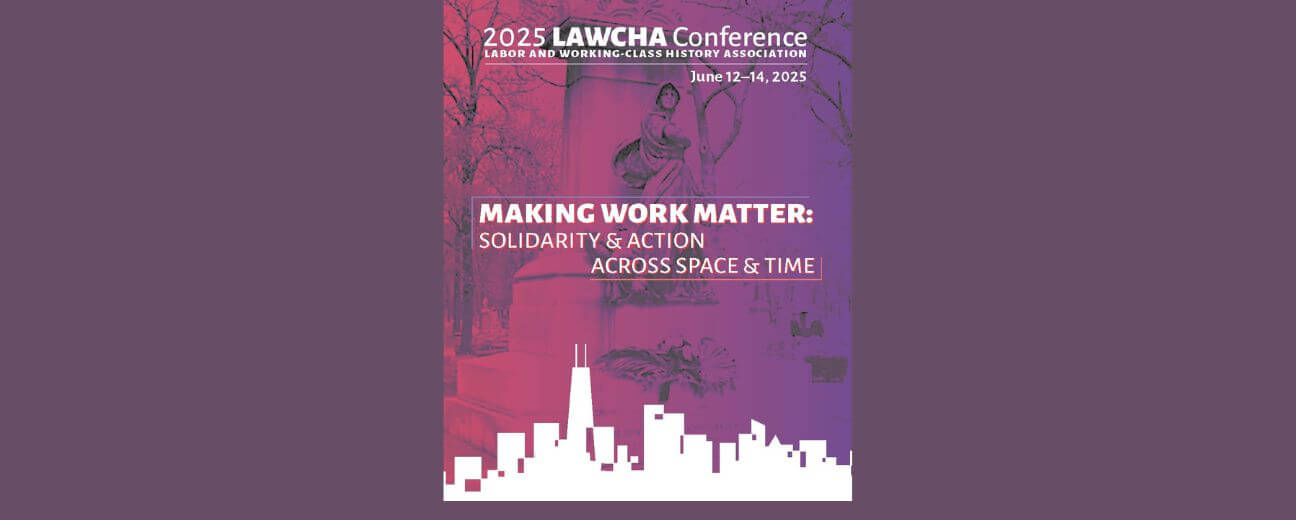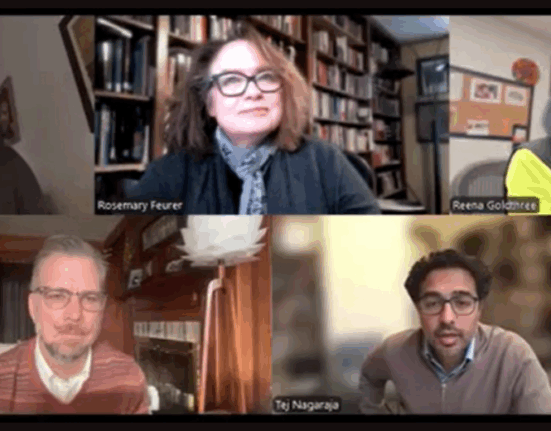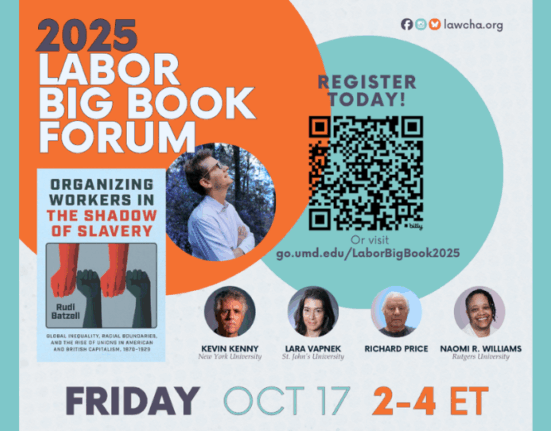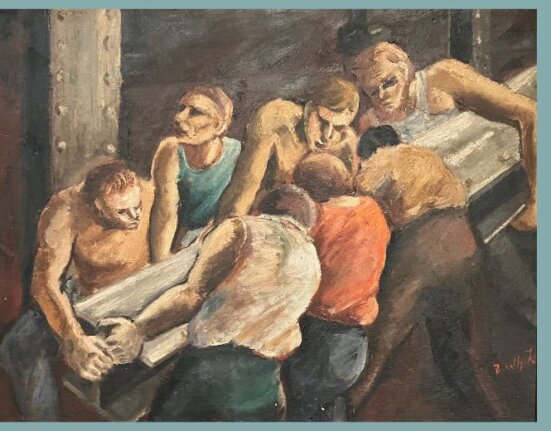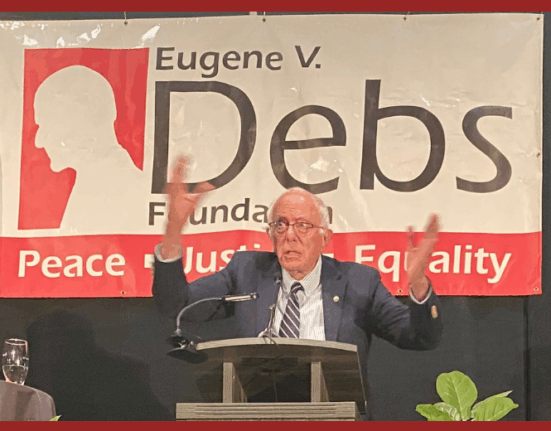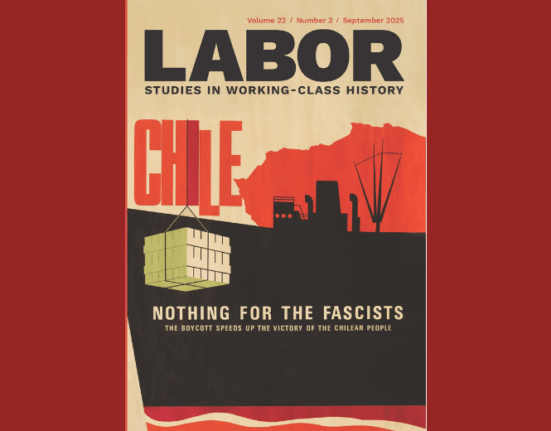We have a few brief summaries of panels and papers from the Labor and Working Class History Association conference, June 2025. In this case, we were delighted to receive this full comment from Nelson Lichtenstein from this panel on Lawyers and the Labor Movement. If you have a comment or summary of a panel or event, send it on so it can be included.

Given the devilishly clever legal strategies employed by virtually every company faced with a union organizing effort, the role played by labor-side lawyers has never been greater or more vital. Even when workers are in an insurgent and self-organizing frame of mind, the barriers to creation of an actual union – at the National Labor Relations Board, in the courts, and within other governmental organs – remain enormous and requires a skilled hand explaining the legal terrain and offering guidance to union leaders, activists, and the rank and file more generally. Today, hundreds of dedicated union lawyers practice their craft in the U.S., but as we’ll see in this brief consideration of three prominent labor lawyers during the CIO era, the role they have played can be a contradictory and difficult one, even for the most progressive of the lot.
Maurice Sugar, Arthur Goldberg, and Joseph Rauh played important roles during the CIO’s heyday, from the Depression and New Deal years until the high noon of industrial unionism in the 1950s and 1960s. All were Jews, which was very much par for the course, since being a legal champion for labor during most of this era spoke to both their own social marginality, their exclusion from the WASP institutions of law and politics, and perhaps also to their “people of the book” facility with words, argument, and textual mastery. Both Maurice Sugar and Arthur Goldberg were the sons of peddlers who had immigrated from Eastern Europe in the 1890s and first decade of the 20th century. Joe Rauh was from a much higher social station, that of a comfortable German-Jewish Cincinnati family whose wealth came from a set of apparel factories. Sugar and Goldberg went to law school at Michigan and Northwestern, Rauh to Harvard, where he came under the mentorship of Flex Frankfurter and became one of the professor’s New Deal hot dogs.
Sugar was a generation older than Goldberg or Rauh and he was generally associated with the Communist faction in the CIO, though probably not a party member. Goldberg and Rauh were anti-Communists but as we’ll see, they diverged sharply on some key postwar issues. But for all of these figures, and other prominent lawyers such as Lee Pressman, the law was both a terrain of struggle and also a constraining framework, even at the height of CIO militancy.
They all faced a political and moral dilemma arising out of the tension these lawyers encountered between their aspirations for and identification with a robust social movement and their professional understanding of how the labor law imposed limits and constraints on that same movement. Regardless of how radical or committed were these lawyers, they all too often served as messengers, transition belts between an increasingly reactionary legal structure and the labor movement they so ardently championed. After a very brief decade or so in which these lawyers explored and expanded the legal freedoms and protections advanced by the early New Deal, a far longer era ensued, in which these lawyers became de facto policemen for the state, reluctant and cleverly resistant, but still the key figures that forced the unions to internalize and accommodate the world of post Taft-Hartley America. Even when these lawyers won a case or negotiation for their union clients, all too often they could only do so by legitimizing the larger structures that constrained the labor movement. That dynamic remains with us today, even in an era of labor’s ideological resurgence.
As Catherine Fisk argues in a forthcoming book on several of these individuals and the unions they served, labor lawyers occupied a liminal position. They saw themselves as part of a social movement. They identified more with their clients than they did with the rest of the legal profession, which was conservative, white, and male. And yet most labor lawyers were hardly proletarians: they could and did make a living, if necessary, outside the union fold, although rarely beyond the boundaries of a larger left liberalism.
Maurice Sugar is a case in point. Born in 1891, Sugar was an anti-war radical by World War I and spent several months in jail, but he always insisted that even the most left-wing lawyer had to deploy a “sharp pencil.” During the injunction era before Norris-LaGuardia and the Wagner Act, that meant using any legal technicality to constrain anti-labor judges and the employers who relied upon such a conservative judiciary. By the late 1920s Sugar had become expert in the use of legal procedure to tie up court proceedings long enough to give strikers a chance to keep their picket lines intact and extract real economic damage on their corporate adversary. Sugar’s favorite tactic was to invoke an old equitable doctrine that courts should not grant an injunction to a party with “unclean hands.” For example, Sugar would argue, sometimes successfully, that it was inequitable, and therefore improper, for a court to enjoin a strike when the strike was prompted by the employer’s own illegal conduct, such as firing union supporters or hiring spies to infiltrate union meetings. Not everyone on the left applauded such a tactic, because Sugar thereby avoided a more direct challenge to the injunction itself or the free speech validity of the picket line.
During the era of the sit-down strikes, and afterward, Sugar worked with all UAW factions to legitimize the strikes and forestall repression from either local or state law enforcement. This was the historically brief window of opportunity that Sugar – as well as Goldberg and Rauh – enjoyed when both the labor movement and the labor law seemed to advance in tandem.
The sit-down strike was ethical because it was the only way that workers could force their employers to abide by the National Labor Relations Act. But Sugar went farther: the sit-down was legal, just like picketing and walk-out strikes. The NLRA had given workers the rights to strike and to have management recognize their union and to negotiate with management over the operation of the business. The statute did not say that workers had to physically absent themselves from the factory in order to exercise their rights. In Sugar’s view, the corporate complaint that the workers were abridging their property rights was no more valid than the claim that a conventional strike was illegal because it also prohibited the free use of company property and production.
But the courts were not the only place where labor lawyers like Sugar were ambitious. I am pretty sure that Sugar was the author of the 1940 UAW pamphlet I have used many times in my labor history classes. It was entitled “How to Win for the Union” and emphasizes the way shop stewards must represent the felt needs of their workmates and mobilize them to win grievances and other shop floor battles. One of the best lines is pure Sugar: “Lawyers have been able to use a Constitution written over 150 years ago to cover the complex issues of modern life. A bright steward should be able to do just about as well with his contract.” This strikes me as indicative of the way that a legal, lawyering sensibility can be organically embrocated with class conflict, not just in the courts and hearing rooms, but right in the guts of the factory.
But that season of legally legitimized worker militancy was a brief one. During World War II and afterward Sugar, for all his own personal leftism, found himself advising restraint and caution on both union leaders and workers alike. As Fisk’s research demonstrates, even before passage of the Taft-Hartley Act in 1947, Sugar was reminding the locals of the need for strike votes and authorizations from the top UAW leadership, as well as the “very heavy financial penalties” for striking in violation of the wartime Smith-Connolly Act. Although Sugar thoug ht federal law restricting strikes could no longer be justified in the months after the end of the war, he nevertheless urged union leaders to demand that restive locals return to work because such an on-the-record order “would be valuable in case of a Smith-Connally suit against the Union.”
Taft-Hartley made things even worse, making illegal a wide variety of tactics, from the shop-floor to the bargaining table, that had once been both legal and commonplace. CIO counsel Lee Pressman said the law “creates a heaven for lawyers,” which is another way of saying that men and women with legal talent and experience moved far closer to the center of union power, displacing not just shop floor militants, but top union officials as well.
The challenge for lawyers like Sugar was to explain to clients and their members how devastating the Taft-Hartley Act was and to provide thorough advice about all the ordinary things that had just become illegal. They had to fend off the welter of state anti-union laws and try to protect union treasuries from the wave of employer damage suits that the law unleashed. They had to do so without becoming what they didn’t want to be: naysayers who crushed the workers’ fighting spirit. Their professional identity told them to advise caution. Their movement activist identity told them to advise against quiescence.
This was the context in which Arthur Goldberg became counsel for both the CIO and the Steelworkers. Goldberg won his labor bon a fides during a bitter, lengthy 1938 Chicago strike against the Hearst newspapers in which he skillfully used some of the new legal tools made available by a largely sympathetic National Labor Relations Board. Goldberg was a liberal anti-Communist, but after the war his leap to the most important legal post the new industrial unions had to offer was not based on any litigation strategy that differed all that much from his Communist oriented opponents. Rather, Goldberg was highly adept at the Washington-centered lobbying cum lawyering that was not all that at variance in method and technique from that of the white-shoe law firms who plunged into the world of New Deal era law-making, agency administration, and regulatory infighting.
There was however one thing that would distinguish Goldberg from both Sugar and Rauh. Goldberg was employed directly and completely by the Steelworkers. He did not maintain a separate practice and so his entire professional identity was bound up with that union. It seems clear that he adopted much of the viewpoint of the union’s top leadership, especially when it came to internal opposition, of which there was an increasing amount in the latter half of the 1950s. The USW had from its origins been an hierarchical organization, reinforced during its million member heyday by the industry-wide bargaining and frequent, massive strikes which punctuated the early postwar decades. Moreover, Goldberg was well aware, unlike many other social commentators and industrial relations experts of that era, that the existence of the union was hardly assured, that the hard-nosed steel executives were probing, seeking to undermine the legal and economic structures erected by the union and its allies in the New Deal order. Goldberg therefore analogized the contest between labor and management not as one pitting Democrats and Republicans against each other in a stable democratic polity, but rather as the kind of conflict that engulfed Britain’s former colonies in the late 1770s, or France a decade later, or the Soviet Union in 1917-1919, when war and subversion put the very existence of these revolutionary new regimes in danger and doubt.
As a consequence, a sort of military discipline was needed by the union, which put Goldberg on the side of the leadership during those rank and file insurgencies that periodically challenged both regional directors and union president alike. Goldberg’s legal talents were therefore deployed to make the union less subject to such democratic impulses.
The career of Joe Rauh took a very different trajectory. He was a liberal New Dealer in a variety of government agencies, an interventionist on the eve of the war, but until about 1941not much of a labor oriented liberal. Two figures were important to his transformation: The UAW’s Walter Reuther, who was then exciting people like Rauh with his advocacy of a “500 plans a day plan” designed to help Britain resist Hitler’s aerial blitz; and A. Philip Randolph, then organizing the first of his two Marches on Washington. Rauh was delegated to write the first drafts of the famous executive order that FDR signed banning racial, religious, and national origins discrimination in war industry. By 1946 when the Reuther forces won control of the UAW, Rauh was a labor liberal of the Americans for Democratic Action sort. Reuther asked him to become the UAW’s full-time counsel in Detroit, but Rauh kept his own law practice in D.C., although the UAW was his most important and remunerative client.
This was important, since it allowed Rauh to become a major player in liberal politics for the next several decades, defending Arthur Miller before HUAC, (the playwriter’s spouse, Marilyn Monroe, stayed with Miller in Rauh’s home), working in civil rights, opposing the war in Vietnam, and playing a role in Democratic Party politics. Some of these activities were at variance with what Reuther and the UAW might have wished. The most high profile of these conflicts undoubtedly came when Rauh supported the Mississippi Freedom Democratic Party at the 1964 Democratic Party Convention. There Reuther was playing hatchet man for LBJ and Hubert Humphrey. When Reuther ordered Rauh to take the compromise scheme LBJ demanded, Rauh told Reuther that the UAW leader was his client, not his boss. Their friendship never fully recovered.
Rauh soon went rogue, at least in union terms. In the 1970s and early 1980s he became persona non grata to many AFL-CIO and UAW officials when he supported a series of union insurgents fighting corrupt and/or autocratic union leaders. He played major roles in helping uncover the murders of UMW leader Jock Yablonski who was challenging the union’s autocrat president, Tony Boyle, in a contest that eventually paved the way for a reform slate to win control of the mine union. Then, answering the call of the stalwart Chicago liberal, Leon Despres, Rauh offered legal counsel to the 33 year old USW reformer, Edward Sadlowski, in his efforts to make the United Steelworkers more responsive to the rank and file; and in the early 1980s he even challenged his old friends in the UAW when he gave legal advice and support to Jerry Tucker and his New Directions movement, which sought to break the stranglehold of an entrenched Administrative Caucus that was increasingly collaborative with the auto companies. Unlike Goldberg, Rauh thought the divisiveness generated by internal democratic contests more than counterbalanced by the new militancy and participation that would now flow through the membership. Throughout these years, Rauh used whatever legal levers he could find at the NLRB and the Labor Department, often deploying the 1959 Landrum-Griffin law to aid his clients. Rauh had been suspicious of that legislation when passed in the late 1950s because the GOP-Dixiecrat alliance used a rhetorical defense of an oppressed rank and file to strengthen some aspects of Taft-Hartley. But the law also contained a sort of union bill of rights for the rank and file, which Rauh now deployed, alongside the democratizing efforts of a whole new generation of New Left union advocates and activists.
So are labor lawyers the transmission belts reluctantly at the service of a repressive legal order? Or are they–or rather can they be–locksmiths unleashing the chains that hobble so many workers, organized or not? A little of both is the unsurprising conclusion.

